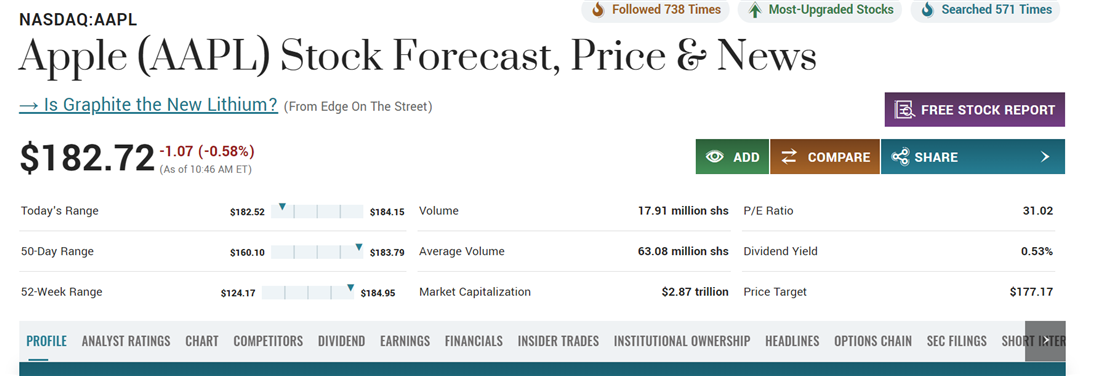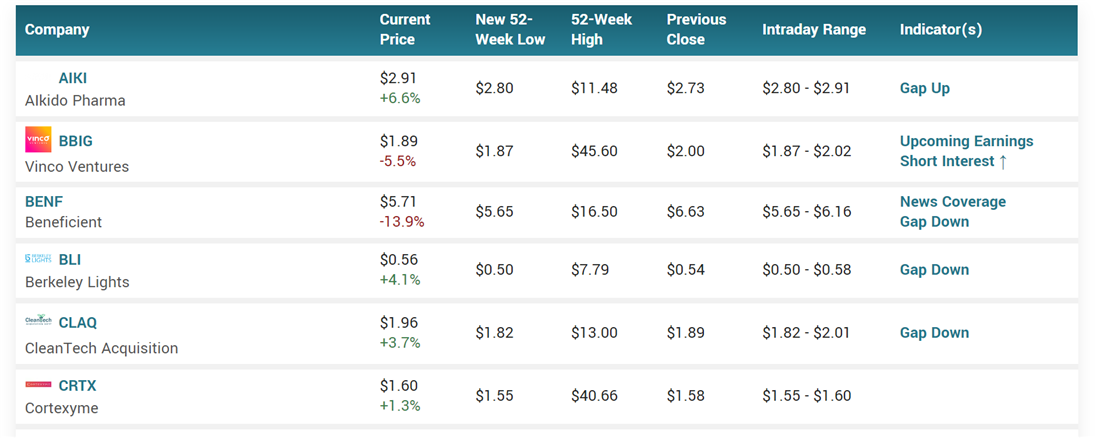As there are 52 weeks in a year, the 52-week period describes pricing differences found within a single calendar year from the date you're looking at it. It contrasts the fiscal year, which usually denotes price highs and lows by quarter or concerning earnings releases.
Wondering, “Where do I find 52-Week highs and lows?” Understanding the significance of a stock's 52-week high and 52-week low can help you make strategic additions to your portfolio, buying in at the ideal time. Some investors may also buy and sell stocks according to highs and lows to execute a short-term trading strategy. Read on to learn about 52 week high and low prices.
Overview: 52-Week Highs and Lows
The 52-week highs and lows are the highest and lowest prices a stock has traded at within the past 52 weeks (one calendar year). Fifty-two-week highs and lows are technical indicators usually used with other price movement indicators to predict how prices will change.
You can calculate 52 week highs and lows using the closing price at the end of each trading day, meaning that a stock may breach its all-time high or low throughout the trading day but be unrecognized at the end of the trading day because the stock price closed at a price within the current 52-week high and low boundaries.
For example, imagine Company A's stock has a current 52-week high price of $100. Company A releases news of an upcoming product launch that pushes the market price to $105 a share throughout a particular trading day. However, by the end of the day, news has died down and the stock closes at a market value of $95. In this example, the 52-week high would remain at $100, despite a few investors paying the price above this during the trading day. Removing outliers from the 52-week high and low equations makes the data more generalized for day-to-day trading.
Where can you find a stock's 52-week high and low prices? Stock resource sites like MarketBeat list each stock's high and low trading prices within the last year. MarketBeat's stock profiles even feature a visual indicator showing how close each asset's current trading price is to the year's high and low prices. MarketBeat also maintains a list of stocks trading at their 52-week highs and 52-week lows, which you can bookmark for quick references throughout the trading days.

Image: Apple's stock is trading near its 52-week high, which you can see in the "52-week range."
Why should you care about a stock's 52-week high and low? The 52 week high-low spread can give you an idea of a stock's volatility and how well it has retained value in the past year. If the stock consistently trades near its 52-week high, it may indicate positive market and media sentiment and potential upward momentum. Conversely, if the stock remains close to its 52-week low, it may suggest negative sentiment and potential downward pressure.
The 52 week high low spectrum can also be seen as potential breakout and breakdown points. If a stock breaks above its 52-week high, it may suggest a bullish signal, indicating that the stock has the potential to continue its upward trend. On the other hand, if a stock falls below 52 week low stocks, it may indicate a bearish signal, suggesting a further decline in the stock's price. This can be particularly important when looking for growth stocks with the potential to produce share price returns on a moderate to short timeline.
Understanding the Significance of 52-Week Low Stocks
Stocks trading at or near their 52-week lows may be undervalued by the market, presenting opportunities for investors. Investors who believe the stock's price has dropped below its intrinsic value may see it as an attractive buying opportunity. Some traders specifically search for stocks trading near a 52-week low to evaluate fundamentals, investing heavily in stocks they believe are mispriced. This strategy is called value investing and can be a viable way to improve portfolio value in the long term.
While value investing is a tried-and-true strategy that may incorporate 52-week low stocks, these stocks are also potentially risky investments. A stock trading at its 52-week low may appear cheap, but it's important to distinguish between an undervalued opportunity and a value trap. Some stocks may be trading at their lows due to fundamental issues or poor prospects for growth.
A stock trading at its low is also more likely to showcase a higher dividend yield that's unsustainable due to the company's poor underlying fundamentals. Some investors fail to look beyond a high dividend yield and low price point combination, only to find their dividends cut by the next quarter. This is referred to as a dividend trap and is something you must look out for when investing in stocks trading at their lows.
Understanding the Significance of 52-Week High Stocks
Stocks trading at or near their 52-week highs may showcase positive market sentiment to continued successful growth or entry into a new market. It suggests that the stock has experienced upward momentum, and buyers have been willing to pay higher prices to own the same percentage share of the company. Positive market sentiment can attract further attention from investors and analysts, potentially creating a positive feedback loop of price discovery.
Various factors can contribute to a stock reaching a new 52-week high, including positive recent financial performance or successful company developments. For example, a pharmaceutical company that produces its first FDA-approved drug will likely see a sudden drastic increase in price mobility, quickly reaching a new high. This high can be a resistance point for future inventors to gauge price movement against.
Benefits of Trading 52-Week Low Stocks
The primary benefit of trading a stock near its 52-week low is the opportunity for rapid stock price appreciation. For a trader, this means the opportunity to make a more profitable trade. Stocks trading at their 52-week lows (especially if in conjunction with a total overall bearish market event like the COVID-19 pandemic) may be inaccurately priced in terms of fundamentals, leading to quick market corrections.
Trading Strategies for 52-Week Low Stocks
Some of the most popular trading strategies for stocks at their 52-week lows include the following.
Value Investing
Value investing is a strategy that involves looking for assets undervalued by the current market. When a stock reaches its 52-week low, it may indicate that the market has undervalued it, presenting an opportunity for value investors. Investors following this strategy would analyze the company's fundamentals, such as its financial health, earnings potential and industry position, to determine if the stock's low price is justified or a great bargain buy.
 Image: MarketBeat's list of the day's 52-week lows can be a great place to look for value investing opportunities.
Image: MarketBeat's list of the day's 52-week lows can be a great place to look for value investing opportunities.
Bottom Fishing
Bottom fishing is a strategy that involves buying stocks at or near their 52-week lows, anticipating a potential price recovery. This strategy requires identifying stocks with solid fundamentals and assessing whether the factors that led to the price decline are temporary or reversible. Bottom fishing can be risky, as it relies on correctly identifying stocks that have reached their true bottom and have the potential to rebound.
Event-Driven Trading
Event-driven traders focus on specific catalysts or events that could trigger price movements in a stock. A trader using the event-driven trading strategy will monitor breaking news before gauging the impact that this news has had on share price. The investor may use technical analysis to identify a potential bottom for the catalyst's impact, buy the bottom if it reaches the stock's 52-week low and sell shortly after recovery.
Pros and Cons of Trading 52-Week Low Stocks
There are both potential benefits and risks to buying stocks at their 52-week lows.
Pros
Stocks trading at their 52-week lows can present rare opportunities for investors to buy into great companies at lower rates.
- Potential for value: Stocks trading at their 52-week lows may be undervalued, presenting an opportunity to buy assets at a discounted price relative to their intrinsic value. It can mean a more valuable portfolio over time, as undervalued stocks are likely to see a market correction as time goes on.
- Higher dividend yield: You can calculate a stock's dividend yield using its annual payout relative to the share price of the stock. Stocks trading at their 52-week lows are likelier to have higher dividend yields, representing passive income opportunities.
- Potential for short-term rebounds: Some stocks tend to overreact to market news. Strategies like bottom fishing help investors see profits by capitalizing on short-term rebounds in price.
Cons
Stocks trading near their low might not be undervalued — they could simply be poor portfolio additions that investors don't want to hold.
- Continued downward trend: Stocks trading at their 52-week lows may be downward for a reason. The stock price could decline if underlying issues like poor sales or failed trials continue.
- Value and dividend traps: Not all stocks trading at their lows are undervalued opportunities. Some stocks may be at their lows for valid reasons, such as poor financial performance, unfavorable industry conditions or declining competitive positions. They may also attract investors with unsustainable dividend yields due to lower share prices.
Using 52-Week Highs and Lows
The most important point you should take away from this rundown on 52-week highs and lows is that you should use this data point in conjunction with other market fundamentals. While a stock trading at a new 52-week low may be undervalued, it might also accurately reflect poor underlying fundamentals. Additionally, a stock undergoing price discovery is not guaranteed to continue to increase in value based on market trends.
FAQs
From large-cap stocks with billion-dollar market caps to penny stocks with high volatility, understanding 52-week highs and lows is important for all assets. The following are some last-minute questions you might have about this data point.
How do you find 52-week high and low?
You can find a stock's 52-week high and low prices on its stock profile page using your favorite market research site. For example, MarketBeat maintains a stock page for each major asset trading on exchanges like the NYSE and NASDAQ, which features 52-week high and low prices.
Is it better to buy at 52 week high or low?
There's no single answer to whether you should buy at a high or low price. Buying stocks at their 52-week highs aligns with a momentum investing strategy, which focuses on capitalizing on trends and positive price momentum. Buying at a 52-week low can be part of a value investing strategy, where you purchase assets undervalued by the market for long-term price increases.
What is the strategy for 52 week high stocks?
The strategy for 52-week high stocks involves capitalizing on positive momentum and potential continued price appreciation. Investors may seek to ride the upward trend, enter breakout opportunities or take advantage of investor confidence. However, remember that these stocks may be overvalued and susceptible to profit-taking or more volatility.